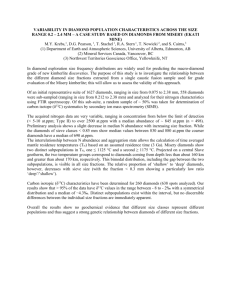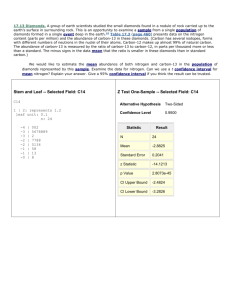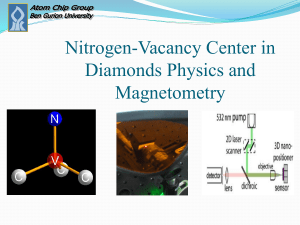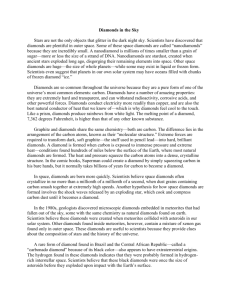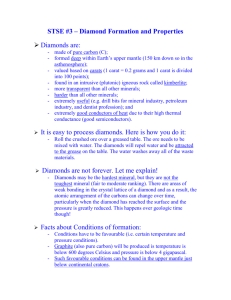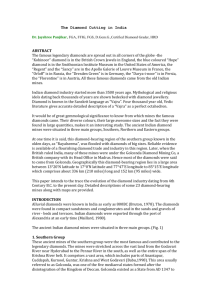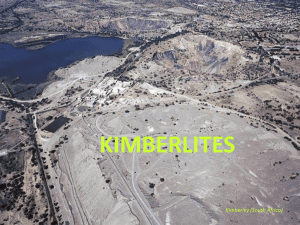Presentation
advertisement
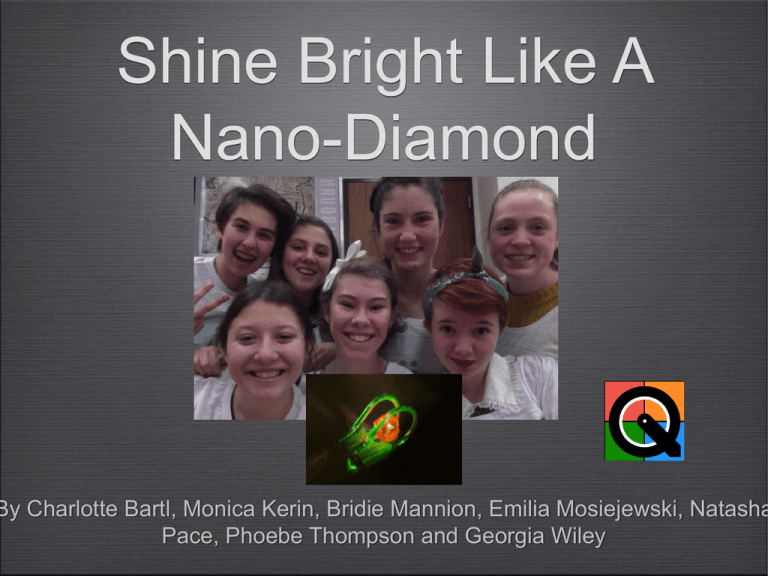
Shine Bright Like A Nano-Diamond By Charlotte Bartl, Monica Kerin, Bridie Mannion, Emilia Mosiejewski, Natasha Pace, Phoebe Thompson and Georgia Wiley Growing Tall Poppies •Enthusiastic Science Students from Star of the Sea College •Growing Tall Poppies initiated by Coherent X-ray Science Group •Centre for Quantum Computation and Communication Technology opened their doors to allow us to experience first hand what goes on in the real world of physics research. •Given a project that allowed us to - talking with senior scientists and postgraduate students - exploring existing equipment and laboratories in the faculty - brainstorming - analysing data - researching Our Project • “Nano-diamond quantum sensors in living cells” • Diamonds and Nano-diamonds - difference in properties • Quantum - Mechanics - Superpositions - Sensors • Nano-diamond’s Nitrogen Vacancies - Quantum Sensors - able to detect small magnetic fields. • Analysing Data - from Nano-diamonds in a biological system. Our Week at CQC2T! Our Week at CQC2T! Our Week at CQC2T! Our Week at CQC2T! Our Week at CQC2T! What is Quantum Mechanics? • Classical physics was the fundamental base of our studies of the universe and all that’s in it. • Today it still remains at the base of our understanding, but in the early 1900’s a problem came about; light. • Light brought properties us and our universe could not explain, like the particle-wave duality. • Classical physics could not explain this and so quantum mechanics was formed. Quantum Mechanics • The quantum world supports superpositions, the real world does not. • A superposition is something, that can in two or more states at once. • A superposition is ultimately eliminated by an observer. This was shown by Erwin Schrödinger’s thought experiment, Schrödinger’s Cat. DIAMONDS - FORMATION • 200km beneath the Earth’s surface in upper mantel • Carbon exposed to high pressure and heat • Bonds to other carbon atoms • Forms diamond lattice • Diamonds at surface due to volcanic eruptions • Volcanic material cooled down at surface and kimberlite formed • We find diamond in kimberlite when mining DIAMONDS - PROPERTIES • Carbon atoms covalently bond • Tetrahedral structure • Invaluable • Hardest known naturally occurring material • Strength comes from tight lattice structure • High refractive index • Electrical insulator • Thermal conductor • Sometimes hydrophobic • Dispersion DIAMONDS - Synthetic • Artificially grown/created • Almost identical to natural diamonds • There are multiple ways to synthetically manufacture diamonds Diamonds - Growing • Tiny diamond seeds • Methane and hydrogen • Plasma • 4 to 5 days compared to 1-3 billion years DIAMONDS- Uses - Machine and cutting tools - Abrasives - Jewellery - Nano-diamond microscopes - Tiny storage space for computers - Window material in lasers and GROW YOUR microwave radiation DIAMONDS IN ME - Used in environments exposed to highradiation (eg: synchrotrons) Diamond’s Structure and Defects • Diamond’s resistance and durability is due to its structure: each carbon atom bonding to three others, forming a pyramid-like structure. • Defects (vacancies or impurities) can change the colour or properties of diamonds. CARBON CROWN The NV Defect • A vacancy located next to a single nitrogen atom. • When a green laser is shined on a diamond with a NV centre, it emits red light. • Even one single NV defect can be detected through a microscope! Nano-Sensors • A device that is used to monitor particles or objects on the nanoscale (10-100 nanometers). • These nano-sensors must be biocompatible: the organism or cell mustn’t suffer any ill effects from the addition of this sensor, while well as remaining functional. NV-Diamonds as NanoSensors • Follow all the requirements for a biocompatible sensor • Also possess a quantum state that can be manipulated by microwaves, meaning that they can be used to measure intricate activities within the live cell. Nano-Diamond’s Activity in the Cell • After being injected, travel through the cytoplasm and may attach to an organelle or motor protein. • This data can be analyised to better understand the activity within cells, leading to possible medical advances. Visualising Technology • Prepare sample, create nano-diamonds by smashing up bigger diamonds, then heating to remove excess graphite coating • Combine with water in which the nano-diamonds are suspended Visualising Technology • Pipette time! Visualising Technology • Then green light is then shined on the diamonds to detect NV centers which shines red. • We are able to detect a single NV defect in a nanodiamond. • Two different techniques to document these nanodiamonds -Confocal -Wide Field Visualising Technology Visualising Technology • Microwaves excite electrons, causes them to jump energy levels • Exploiting the quantum properties in the NV center allows to make more sensitive observations then would be seen in classical systems • Strange quantum properties can help use learn about the outside environment trying to collapse this fragile quantum state. • A property of nano-diamonds is their sensitively towards not only magnetic fields but also temperature and pressure. This is what allows us to make measurements inside the cell, which otherwise is extremely difficult to make in a single cell. Nano-diamond sensor data in graphs • These graphs represent data collected of the paths of nanodiamond sensors in cells. • The first graphs show an overhead view of the nano-diamond paths, which may be freely diffused or drifted with diffusion. • The second graphs show the general displacement of the nano-diamonds in a line, which show clearly if the paths are free or drifted. Nano-diamond sensor 4 • The first graph shows that the path has a strong upward direction that may indicate drift from an external force. • The second graph confirms that the nano-diamond’s path is diffused with drift. The velocity is 0.71942 micron/sec and a drift velocity of 0.173007 micrometers squared. Nano-diamond sensor 7 • The first graph shows that the path is brownian and spread across the grid fairly equally but is slightly more clumped towards the lower region. It doesn’t appear to have any drift. • The second graph confirms that the nano-diamond sensor’s path is freely diffused. It has a velocity of 0.24938. What Now? • How can this research be put into use? • Will it be beneficial? • Nano-imaging • Charles Hill • Victor Perunicic • Mark Kowarsky • Kristin Jovanoski • Dan Thompson • Alistair Stacey • Roland Szymanski • Sam Lichter Acknowledgements!

